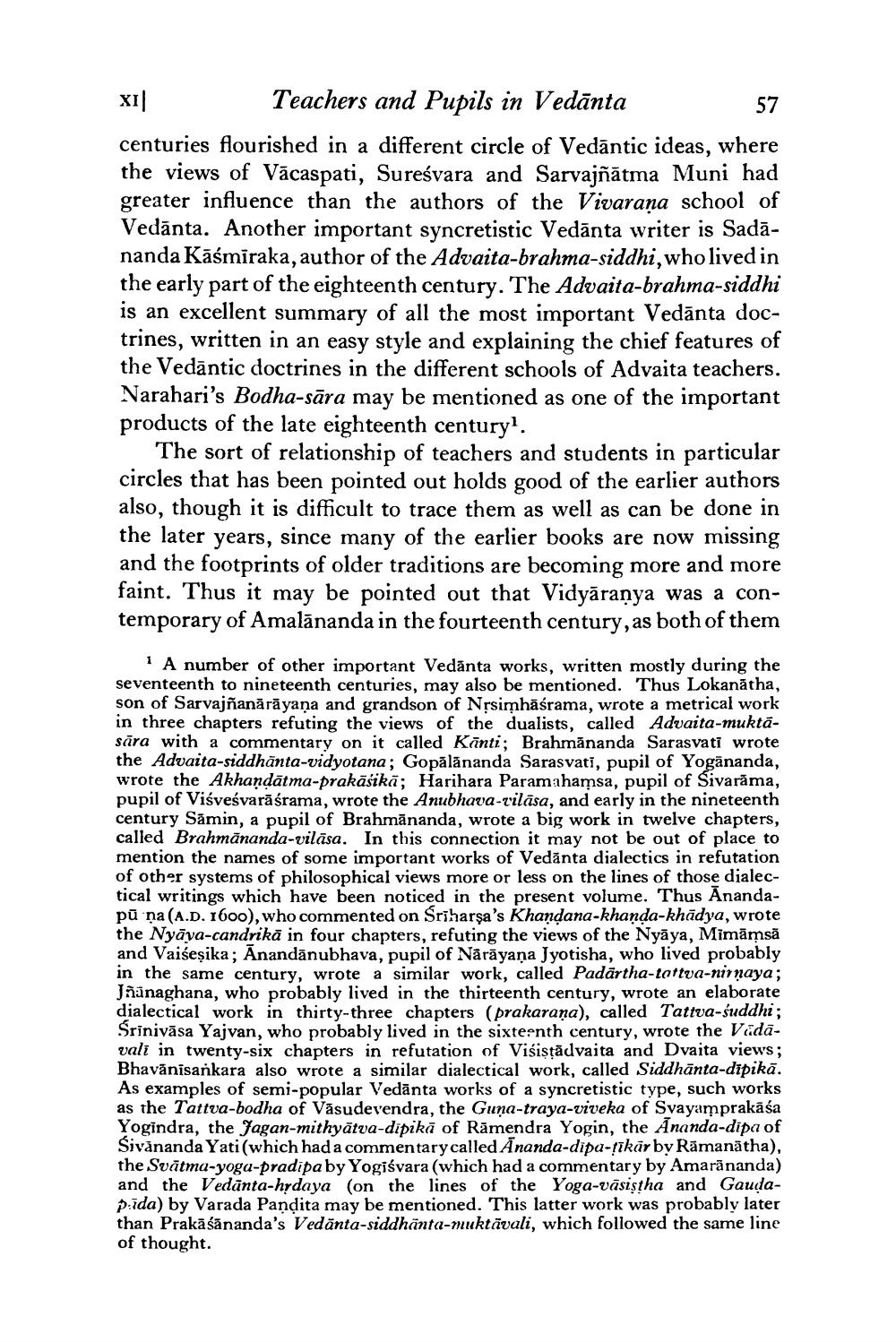________________
57
XI
Teachers and Pupils in Vedānta centuries flourished in a different circle of Vedāntic ideas, where the views of Vācaspati, Sureśvara and Sarvajñātma Muni had greater influence than the authors of the Vivarana school of Vedānta. Another important syncretistic Vedānta writer is Sadānanda Kāśmiraka, author of the Advaita-brahma-siddhi, who lived in the early part of the eighteenth century. The Advaita-brahma-siddhi is an excellent summary of all the most important Vedānta doctrines, written in an easy style and explaining the chief features of the Vedāntic doctrines in the different schools of Advaita teachers. Narahari's Bodha-sāra may be mentioned as one of the important products of the late eighteenth century?.
The sort of relationship of teachers and students in particular circles that has been pointed out holds good of the earlier authors also, though it is difficult to trace them as well as can be done in the later years, since many of the earlier books are now missing and the footprints of older traditions are becoming more and more faint. Thus it may be pointed out that Vidyaranya was a contemporary of Amalānanda in the fourteenth century, as both of them
A number of other important Vedānta works, written mostly during the seventeenth to nineteenth centuries, may also be mentioned. Thus Lokanātha, son of Sarvajñanārāyaṇa and grandson of Nrsimhāśrama, wrote a metrical work in three chapters refuting the views of the dualists, called Advaita-muktāsāra with a commentary on it called Kanti; Brahmānanda Sarasvati wrote the Advaita-siddhānta-vidyotana; Gopālānanda Sarasvati, pupil of Yogānanda, wrote the Akhandātma-prakāśikā; Harihara Paramahamsa, pupil of Sivarama, pupil of Viśvesvarāśrama, wrote the Anubhava-vilāsa, and early in the nineteenth century Sāmin, a pupil of Brahmānanda, wrote a big work in twelve chapters, called Brahmananda-vilāsa. In this connection it may not be out of place to mention the names of some important works of Vedānta dialectics in refutation of other systems of philosophical views more or less on the lines of those dialectical writings which have been noticed in the present volume. Thus Anandapū na (A.D. 1600), who commented on Sriharşa's Khandana-khanda-khādya, wrote the Nyāya-candrikā in four chapters, refuting the views of the Nyāya, Mimāmsā and Vaiseşika; Anandānubhava, pupil of Nārāyaṇa Jyotisha, who lived probably in the same century, wrote a similar work, called Padārtha-tattva-nirnaya; Jnanaghana, who probably lived in the thirteenth century, wrote an elaborate dialectical work in thirty-three chapters (prakarana), called Tattva-suddhi; Srinivasa Yajvan, who probably lived in the sixteenth century, wrote the Vidāvali in twenty-six chapters in refutation of Visisţădvaita and Dvaita views; Bhavānisankara also wrote a similar dialectical work, called Siddhānta-dipikā. As examples of semi-popular Vedānta works of a syncretistic type, such works as the Tattva-bodha of Vasudevendra, the Guna-traya-viveka of Svayamprakāśa Yogindra, the Jagan-mithyātva-dipikā of Rāmendra Yogin, the Ananda-dipa of Sivananda Yati(which had a commentary called Ananda-dipa-tīkār by Rāmanātha), the Svātma-yoga-pradipa by Yogiśvara (which had a commentary by Amarānanda) and the Vedānta-hrdaya (on the lines of the Yoga-vāsistha and Gaudap:īda) by Varada Pandita may be mentioned. This latter work was probably later than Prakāśānanda's Vedānta-siddhānta-muktavali, which followed the same line of thought.




